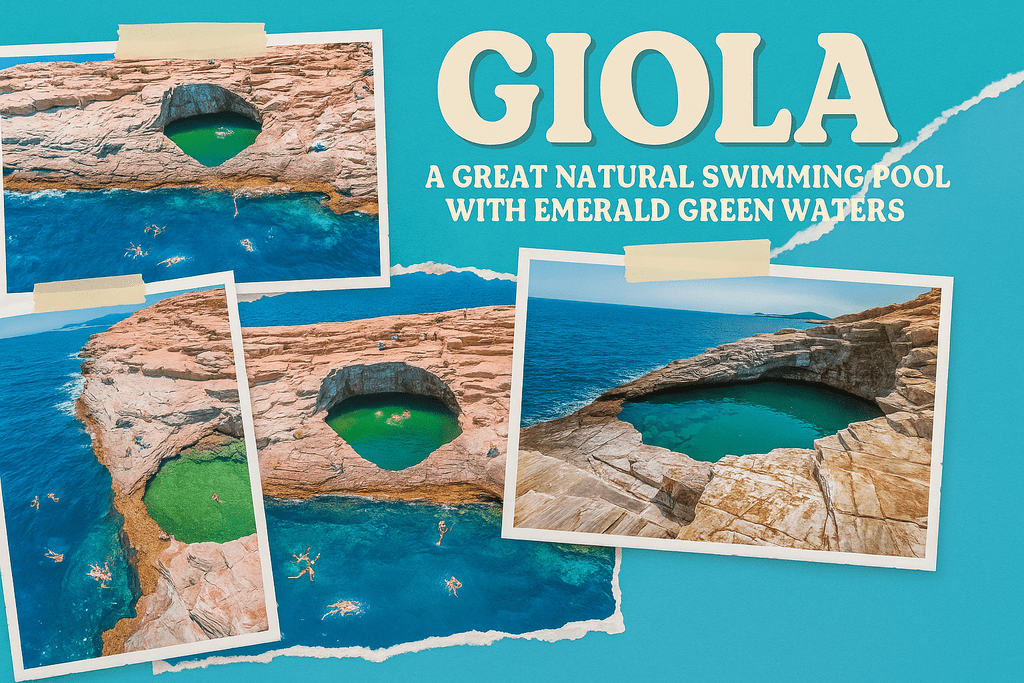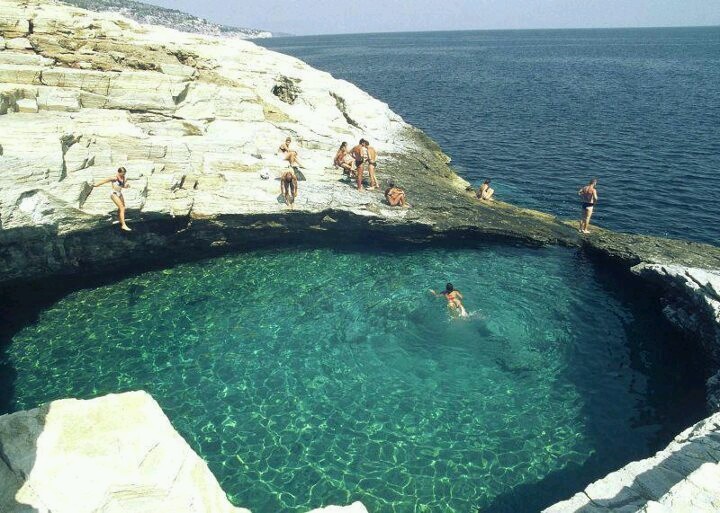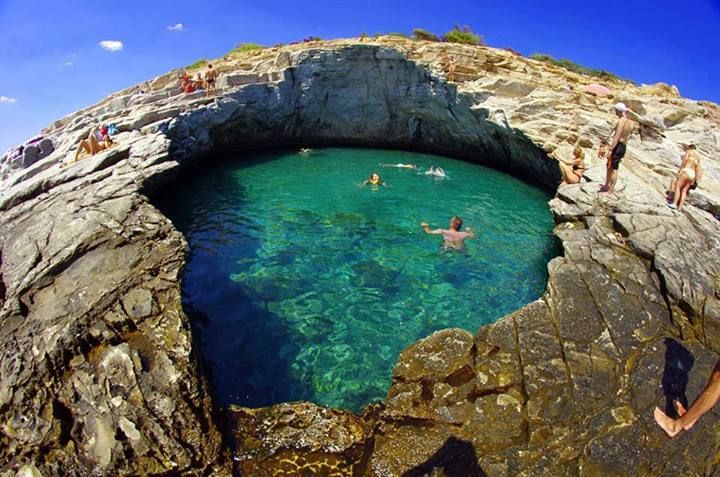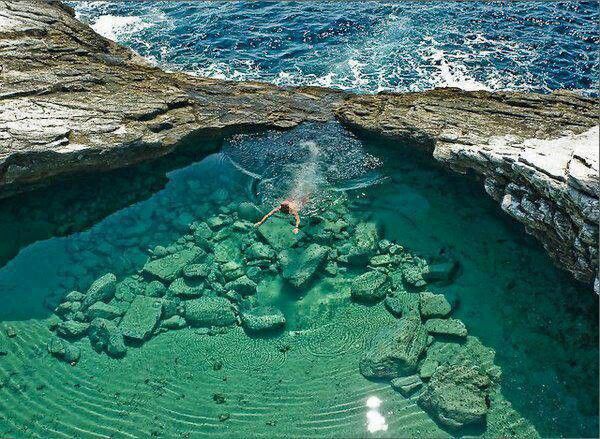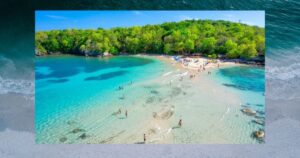Giola a great natural swimming pool with emerald green waters
Discovering the Secret of Thassos Island
On the southern coast of Thassos Island in Greece lies one of the Aegean’s most breathtaking natural wonders – Giola, a stunning natural rock pool carved out by time and waves, shimmering in emerald and turquoise hues. Often called “the tear of Aphrodite,” Giola is no ordinary swimming spot. It’s a hidden sanctuary surrounded by raw cliffs, with crystal-clear waters that look like they belong to another world.
Unlike the polished and often crowded beaches of Mykonos or Santorini, Giola remains refreshingly untouched and uncommercial, making it an ideal stop for travelers seeking something truly special, a slice of nature shaped by the sea’s gentle but relentless hands. What makes Giola so captivating isn’t just its visual appeal. It’s the experience of the journey to get there, the contrast between the wild Aegean Sea just a few meters away and the calm, sheltered water inside the pool, and the raw, primal beauty of the rocks that frame this natural formation. This place feels like a secret, known only to those willing to take the time to explore beyond the main roads and ferry lines.
How to Reach Giola and What to Expect
Getting to Giola is part of the adventure. You’ll first need to reach the island of Thassos, located in the northern Aegean Sea. The easiest route is to take a ferry from the mainland port of Keramoti to Limenas (Thassos Town). From there, it’s about a 40-minute drive south to the Astris region, where Giola is located. The exact site of the pool isn’t directly on the road, which means you’ll have to park your car or scooter along the unpaved access road and hike about 10-15 minutes down a rocky path to reach the coast. Good walking shoes are recommended—the terrain is uneven, and under the summer sun, it can get quite hot. Carry plenty of water and some snacks, especially if you’re planning to stay for a few hours. Once you reach the cliffs, the reward is immediate.
Giola reveals itself like a gem embedded in stone, a perfect oval pool set just above the crashing waves of the sea. Its waters are warm, shallow near the edges and deeper in the middle, making it an ideal place to swim, float, or even jump in from the surrounding rocks. Adrenaline seekers often climb the natural ledges to dive into the pool from heights of up to eight meters, although caution is strongly advised—always check the depth and be mindful of slippery edges.
Practical Info: Entrance, Costs, and Facilities
One of the best things about Giola is that it remains a free natural attraction. There’s no entrance fee or fences blocking access—just the open coast and the path that leads you to it. However, due to its increasing popularity in recent years, especially during July and August, small kiosks have appeared near the parking area selling cold drinks, local honey, and basic snacks. You won’t find full-scale restaurants or toilets directly on site, but several tavernas and beach bars can be found in nearby Astris or Potos, both of which are about a 10-minute drive away.
If you want to enjoy Giola without the crowds, the best time to visit is early in the morning before 10 AM or late in the afternoon, around 6 PM, when most tourists start heading back. For photography lovers, the golden hour just before sunset offers fantastic lighting that brings out the vivid contrast between the dark rocks and green-blue water.
What to Pack and Wear
When planning your visit, pack light but smart. Swimsuit, towel, sturdy sandals or trainers, and a hat are essentials. The rocks can get extremely hot during midday, so having something to sit on (like a beach mat) is a good idea. If you’re planning to jump into the pool, consider wearing water shoes to protect your feet from sharp rocks or sea urchins. Don’t forget sunscreen—it’s an open area with very little shade. Bringing a waterproof bag or pouch for your phone or camera is a good idea if you want to take photos without risking damage from splashes or accidental drops into the water. If you have a drone, this is one of the most photogenic spots on Thassos—just make sure to fly responsibly and check for any updated local regulations.
When to Visit and How Long to Stay
Giola is best visited between late May and early October when the weather is warm and the sea is calm. Spring offers a quieter experience with fewer tourists, while September and early October bring mild weather and warmer water temperatures. During high season, the area can get crowded, so plan your visit during off-peak hours for the best experience. Most travelers spend 1 to 2 hours here, enough time to swim, relax, and snap a few iconic photos. If you come prepared with drinks and snacks, you might find yourself wanting to stay longer just to soak in the raw beauty of this rare natural pool. If you’re doing a round trip of the island, combine your visit with nearby spots like Psili Ammos Beach or the Monastery of Archangel Michael for a full day of coastal discovery.
The True Beauty of Giola
Giola is more than just a pretty photo on Instagram. It’s a place where you can truly feel the connection between nature and myth, a place that requires a bit of effort to reach and rewards you with peace, wonder, and perhaps even a little perspective. Whether you’re a solo traveler looking for hidden corners, a couple chasing unforgettable views, or an adventurer ready to leap from the rocks into the clear depths, Giola offers a moment outside of time. In a world filled with curated experiences and crowded tourist traps, Giola reminds us that some of the best destinations are still the ones we find by walking off the beaten path and into the embrace of the natural world.
Images via: Pinterest

